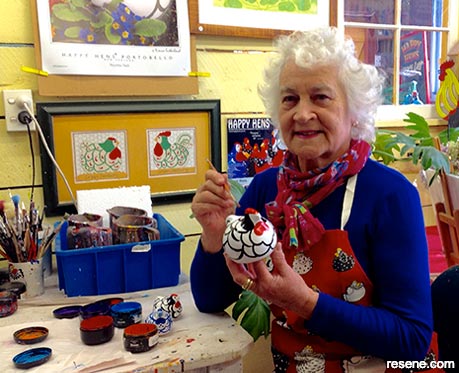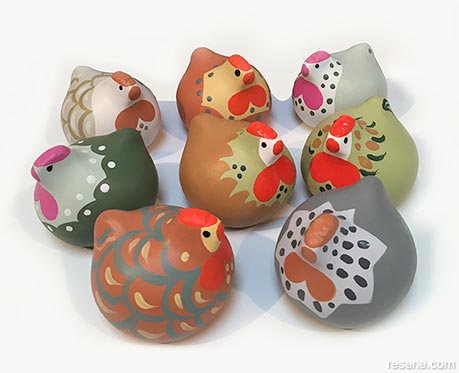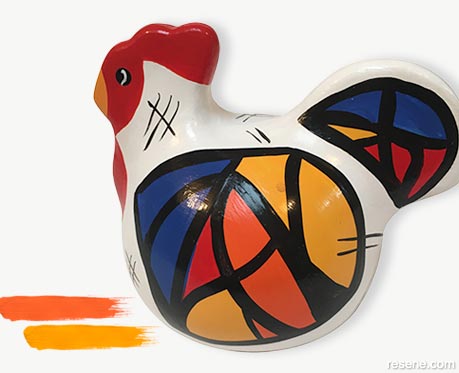From habitat magazine - issue 37, colourful person
Yvonne’s Sutherland’s brood of ceramic Happy Hens, cheerfully painted in Resene colours, are all they are cracked up to be.

Yvonne Sutherland has been ruling the roost at Happy Hens for nearly 40 years. Resene Black, Resene White and Resene Flash Point are her go-to colours for her heritage hen designs.
They sit, broodily, on many a mantelpiece, windowsill, atop a fridge – anywhere that provides a comfortable roost. A Wyandotte, pencilled Hamburg, Norfolk, Light Sussex or even Black Ancona, all resplendent in their bright Resene colours and simplified but easily recognisable patterns.
Whatever the breed, they’re Happy Hens, and, from Portobello in Dunedin, they’ve been making people happy worldwide for nigh on 40 years. That’s how long it’s been since Yvonne Sutherland moulded and painted her first – the bird that hatched her ever-popular ceramic Happy Hens. An art teacher then, she was clay modelling with her class and shaped up a small, round hen. It was logical to paint it, and she was pleased with the bright and happy result.
With encouragement from her husband John, who introduced clay-work into Otago schools in the late 1960s, she started moulding and painting more, inspired by the decorative heritage hens colonial women brought to New Zealand. “I based some of my first designs on them and started selling them at markets. From there, they caught on, and Happy Hens grew and grew.”
Then, and always, Yvonne applies their bright hues with Resene paint. “An architect friend mentioned Resene, saying, ‘Those are the paints architects use.’ I also really liked – and still do – the availability of Resene colours in small quantities so I could test-drive them. Bravo for Resene testpots; the best thing since sliced bread! And, of course, the colour range is fabulous.”


Yvonne’s customers thought her hens were gorgeous and still do. “All cultures can relate to hens and roosters, and most people have warm associations with hens. I’ve been asked to do others such as kiwis and sheep over the years, but no, I’ve stuck to hens. I think that’s part of the success – to concentrate on one idea and develop it into an instantly recognisable brand that’s fun and colourful.”
When she started painting Happy Hens, Yvonne used Resene Lumbersider, a waterborne low sheen paint based on a tough waterborne resin, before applying a gloss topcoat. But, using her favourite Resene Enamacryl gloss waterborne enamel, she now paints directly onto clay blanks, eliminating the final glossing. “Resene Enamacryl gives the required shine. It’s taken a whole step out of my work system,” she says. “Sometimes I will still use Resene Lumbersider to create a flat base, then add a high-gloss design with Resene Enamacryl, which creates an extra dynamic.”
With a customer base built up over four decades, Happy Hens have been adopted into households worldwide, including many given as gifts to VIPs visiting Dunedin. Pre-pandemic, Yvonne’s Portobello store was a destination for Happy Hen seekers, but with the border closures, Yvonne closed her shop and now paints from her home studio. Luckily, her online sales stayed strong, so her Happy Hens continue to fly off around the world.
“It’s wonderful that people still love the Happy Hens,” she says. “They’re a unique little keepsake, and they’re very tactile – they sit so happily in the palm of your hand. But it’s also about their colour. Colour lifts people’s spirits, and it’s an absolute delight to use Resene colours. We have been partners since the very start of Happy Hens!”
![]() Resene Enamacryl is a waterborne gloss paint with the durability of a traditional solventborne enamel. This quick drying, non-yellowing formula is suitable for areas that traditionally require extra durability, such as front doors, architraves, windowsills – and Happy Hens!
Resene Enamacryl is a waterborne gloss paint with the durability of a traditional solventborne enamel. This quick drying, non-yellowing formula is suitable for areas that traditionally require extra durability, such as front doors, architraves, windowsills – and Happy Hens!
Words: Lee-Anne Duncan
Images: Laura Sutherland
Search habitat magazine stories
Printed copies of habitat highlights are available from late March 2024 at Resene ColorShops and resellers, while stocks last. You can view back issues of habitat magazine online.
Specifiers:
If you have an idea, project or story that you think would suit habitat, we’d love to hear from you. Please drop us an email with your details and include photos if submitting a project.
Sign up for a DIY card and Save! Australia | New Zealand